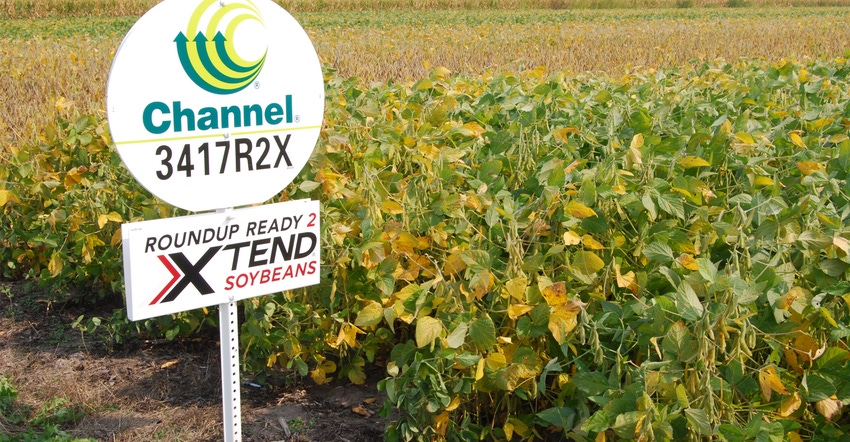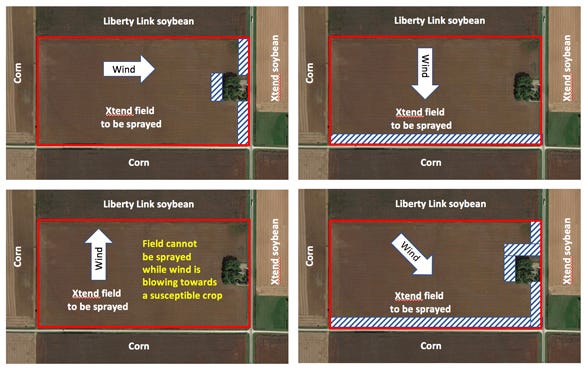
If you are planning to use any of the three new dicamba herbicide products on dicamba-resistant soybean varieties this year, you must follow new label directions.
In response to problems with off-target movement and injury to susceptible crops associated with dicamba application on dicamba-resistant (Xtend) soybeans last year, the EPA made significant changes to the labels of these products. While much of the discussion has focused on the “restricted use” designation and the requirement for applicators to receive dicamba-specific training, EPA also clarified how downwind buffers and protection of susceptible crops are to be implemented.
Iowa State University Extension weed scientist Bob Hartzler discussed the label changes at the ISU Crop Advantage Series and other meetings around the state this winter. He and colleague Mike Owen fielded a lot of questions from farmers and other applicators. Hartzler drew the accompanying map, which he and Owen used in their presentations to illustrate the requirements for establishing buffers and avoiding drift onto susceptible crops.
Application timing makes a difference
Hartzler and Owen are recommending only preemergence application of dicamba on soybean acres. Postemergence is too risky, they said, due to dicamba’s potential for volatility drift even with the new low-volatility products.
Keep in mind the new labels require using downwind buffers and protection of susceptible crops, whether you apply dicamba postemergence or preemergence on dicamba resistant beans.
Hartzler provided the following explanation and observations on what dicamba users need to do to legally apply these products.
Downwind buffers. The labels state that a 110-foot-wide downwind buffer must always be maintained from the field edge (a 220-foot buffer is required if an application rate greater than 22 ounces of Xtendimax with Vapor Grip Technology or FeXapan with Vapor Grip Technology is used). Four areas can be included in the buffer distance when they are directly adjacent to the field:
1. roads, paved or gravel surfaces
2. agricultural fields planted to crops tolerant to dicamba (grasses, Xtend soybeans)
3. ag fields prepared for planting
4. areas covered by buildings or structures with walls and or roof

IN THE FIELD: This illustration shows the influence of wind direction on restrictions regarding downwind buffers and susceptible crops when using dicamba on dicamba-resistant soybean varieties.

The implication of this restriction is that in most situations, said Hartzler, a portion of the field will need to be left untreated due to the downwind buffer (see drawing). EPA has clarified that the vegetation in the area between a field edge and a road is not considered part of the road. Thus, if the wind is blowing toward a road, the buffer needs to be established in the field regardless of what is found in the field across the road. It does not matter whether the roadside vegetation is maintained with mowing or other management practices.
If permanent perennial vegetation is present between two adjacent fields, a downwind buffer is required. The label states that downwind buffers are required at field edges; thus, perennial vegetation found in terraces and waterways within fields do not require buffers.
Susceptible crops. The labels say do not apply the product when wind is blowing toward adjacent susceptible crops. Soybean varieties without the dicamba-resistance trait are considered a susceptible crop, Hartzler said. Users of the new dicamba products will need to determine whether soybeans planted in adjacent fields are dicamba-resistant or not. The label doesn’t specify a minimum distance required between treated fields and susceptible crops. However, a susceptible crop immediately across a road would be considered “adjacent.” If there is a susceptible crop across the road and the wind is blowing in that direction during application, application is not allowed.
The requirements for downwind buffers and protection of susceptible crops add to the complexity of using dicamba in dicamba-resistant soybeans, Hartzler noted. Users of the products need to carefully evaluate all fields prior to spraying season to determine where downwind buffers may be required and if susceptible crops are present in adjacent fields. Restrictions for downwind buffers and susceptible crops aren’t affected by wind speed; they are required even with low wind speeds. The labels restrict applications to periods when winds are at least 3 mph and less than 10 mph.
What about 2,4-D? The 2,4-D products (Enlist One and Enlist Duo) registered for use on 2,4-D resistant corn and soybeans also have requirements for downwind buffers and protection of susceptible crops, Hartzler said. However, the downwind buffer with the 2,4-D products is 30 feet rather than the 110-foot width specified for dicamba products. These products cannot be applied if the wind is blowing towards commercially grown tomatoes, grapes, cucurbits or other fruiting vegetables. Soybean varieties that do not possess the 2,4-D resistant trait are not considered a susceptible crop. As we go to press in late February, Enlist soybeans have not been approved for import by China.
About the Author(s)
You May Also Like




